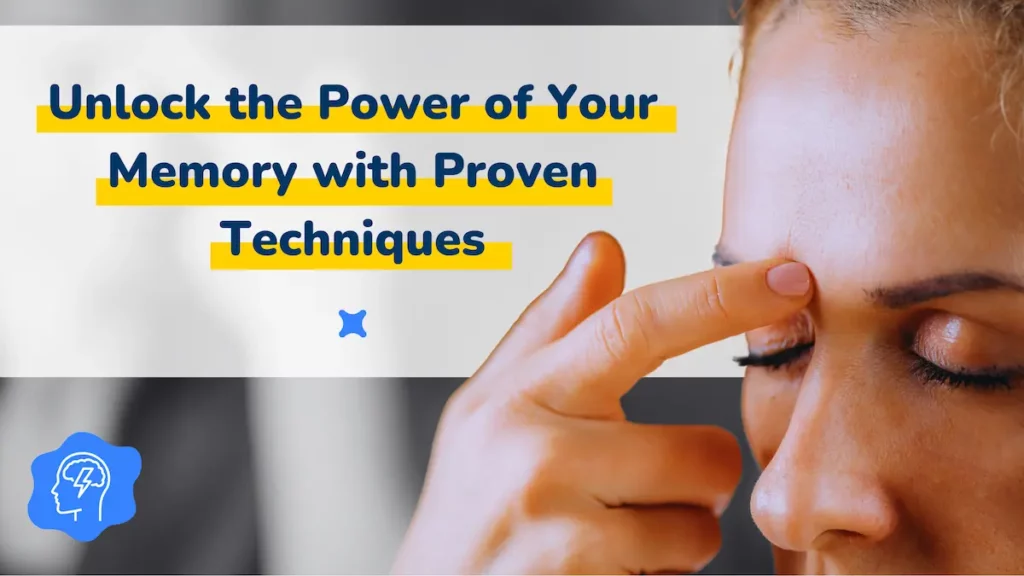Improving your memory is not just beneficial—it’s transformative for both daily life and professional success. Throughout history, memory enhancement techniques have been developed and refined into powerful cognitive tools. This guide delves into these methods, illuminating how they can significantly boost your memory retention and recall capabilities, thus enhancing your overall cognitive function.
Essential Techniques for Memory Enhancement
Memory Palaces (Method of Loci)
The Memory Palace, or Method of Loci, is a time-honoured technique dating back to ancient Greece. You may have seen the memory palace in action during a Sherlock Holmes episode. By visualising a familiar space, such as your childhood home, and associating elements of the information you need to remember with specific locations within this space, you harness your spatial memory to improve recall. This method is particularly effective for sequential information and can be expanded or adapted depending on the complexity of the data you need to retain.
How to Create a Memory Palace
- Choose Your Palace: Select a place you know well. It could be your house, your workplace, or even a favorite park.
- Identify Distinct Locations: Pick specific spots within this place to serve as “loci” or locations. For instance, in your house, you might use your front door, living room sofa, kitchen table, etc.
- Associate Information: Link each piece of information to a specific location. Visualise it vividly interacting with that location.
Benefits of the Memory Palace
- Enhanced Recall: By using spatial memory, you can recall information more accurately.
- Flexibility: Adaptable to various types of information, from lists to detailed concepts.
- Creativity Boost: Encourages creative thinking by forming unique visual associations.
Peg System
The Peg System involves linking each item you need to remember to a rhyming word (one-sun, two-shoe, etc.). This method employs vivid, interconnected images to organise and simplify the recall process. By creating a mental linkage between abstract information and concrete images, the Peg System allows for quicker and more reliable memory recall.
Steps to Use the Peg System
- Create a Peg List: Develop a list of pegs that rhyme with numbers (e.g., 1-sun, 2-shoe).
- Visualise Interactions: For each item to remember, create a vivid mental image of it interacting with the peg (e.g., for item 1, imagine a sun interacting with that item).
- Recall Using Pegs: To recall, think of the peg and the associated image.
Advantages of the Peg System
- Simplicity: Easy to learn and apply.
- Versatility: Can be used for various types of information, particularly lists.
- Efficiency: Speeds up the recall process through vivid imagery.
Chunking
Chunking breaks down large pieces of information into smaller, more manageable units. This method is incredibly useful for memorising numerical data, such as phone numbers or other long sequences, by grouping them into segments. It reduces the cognitive load and makes the information easier to handle and recall.
Implementing Chunking
- Identify Information to Chunk: Choose the information that needs chunking, such as a phone number.
- Divide into Groups: Break the information into smaller, logical groups (e.g., 555-1234 becomes 555-12-34).
- Practice Recall: Repeatedly practise recalling the information in chunks.
Benefits of Chunking
- Reduced Cognitive Load: Makes large amounts of information more manageable.
- Improved Retention: Easier to remember smaller units of data.
- Wide Applicability: Useful for both numerical and textual information.
Acronyms and Acrostics
Acronyms form a word using the initial letters of each item in a list, while acrostics create a memorable sentence where each word begins with the first letters of the information to be remembered. Both techniques are excellent for memorising longer lists of data in a structured, simplified manner.
Creating Effective Acronyms and Acrostics
- List the Items: Write down the items you need to remember.
- Form an Acronym: Take the initial letters of each item and form a word.
- Create an Acrostic: Form a sentence where each word starts with the initial letters of the items.
Examples and Uses
- Acronym Example: HOMES for the Great Lakes (Huron, Ontario, Michigan, Erie, Superior).
- Acrostic Example: “Every Good Boy Does Fine” for the lines of the treble clef in music (E, G, B, D, F).
Link Method
The Link Method involves creating a narrative or story that connects seemingly unrelated items. By establishing associative links between pieces of information, this method builds a strong memory chain that aids in retaining and recalling details more effectively.
Steps to Use the Link Method
- List Items to Remember: Write down all the items you need to memorise.
- Create a Story: Develop a narrative that links each item in a sequence.
- Visualise the Story: Form vivid mental images for each part of the story.
Benefits of the Link Method
- Engaging: Makes memorisation fun and engaging.
- Effective Recall: Helps in recalling information by following a narrative.
- Adaptability: Suitable for various types of information.
Spaced Repetition
Spaced Repetition leverages the psychological spacing effect by reviewing material at increasingly longer intervals. This technique is especially beneficial for long-term retention and is widely used in academic and professional learning environments to embed knowledge deeply.
Implementing Spaced Repetition
- Identify Information to Learn: Choose the material you need to memorise.
- Schedule Reviews: Plan reviews at intervals (e.g., after 1 day, 1 week, 1 month).
- Practice Regularly: Review the information according to the schedule.
Advantages of Spaced Repetition
- Long-Term Retention: Effective for embedding information in long-term memory.
- Structured Learning: Provides a clear review schedule.
- Proven Effectiveness: Widely used and supported by research.
Advanced Memory Enhancement Techniques
PAO System (Person-Action-Object)
The PAO System assigns each piece of information (e.g., a number) a person, an action, and an object, creating a vivid, memorable image. This method is particularly useful for complex data sequences, such as long numbers or detailed instructions, as it forms a highly detailed mental image that aids in both retention and recall.
Steps to Use the PAO System
- Create PAO Associations: Assign a person, an action, and an object to each number or piece of information.
- Visualise Scenarios: Create vivid mental images involving the person performing the action with the object.
- Practice Recall: Review and practise these images regularly.
Benefits of the PAO System
- Detailed Imagery: Enhances recall with vivid, detailed images.
- Complex Information: Effective for memorising complex data sequences.
- Engagement: Makes learning more engaging and enjoyable.
Leveraging Virtual and Augmented Reality
Modern technology offers new ways to enhance traditional memory techniques through Virtual and Augmented Reality (VR and AR). These tools allow for the creation of immersive and interactive memory palaces, providing a modern twist on the ancient Method of Loci. VR and AR can simulate environments where learners can interact with their mnemonics in a virtual space, significantly enhancing the memorisation process.
Using VR and AR for Memory Training
- Create Virtual Environments: Use VR or AR to design detailed memory palaces.
- Interact with Mnemonics: Engage with the mnemonic devices within these environments.
- Practice Regularly: Utilise these virtual tools regularly to reinforce memory retention.
Advantages of VR and AR
- Immersive Learning: Provides an engaging and immersive learning experience.
- Enhanced Recall: Interaction with mnemonics in a virtual space improves recall.
- Modern Techniques: Integrates technology with traditional memory techniques.
How inGeniusly Streamlines Memory Enhancement Techniques
Personalised Learning Through the Inner Genius Assessment
inGeniusly’s proprietary Inner Genius Assessment is crucial for identifying an individual’s unique cognitive strengths and learning preferences. This personalised assessment helps tailor memory enhancement strategies to each person’s specific needs, maximising the effectiveness of the techniques.
Benefits of the Inner Genius Assessment
- Tailored Strategies: Customises memory techniques based on individual cognitive profiles.
- Maximised Effectiveness: Ensures that each person uses the most effective methods for their needs.
- Personal Growth: Supports personal development and cognitive improvement.
Simplifying Complex Techniques
inGeniusly excels in demystifying complex memory techniques and making them accessible and practical for everyday use. Through their platform, users can access step-by-step guides, interactive tutorials, and hands-on practice sessions that simplify the learning process. This approach ensures that individuals can not only learn but also apply these techniques effectively in their daily lives, whether for personal development or professional advancement.
Making Memory Enhancement Techniques Accessible
- Step-by-Step Guides: Provides clear, easy-to-follow instructions.
- Interactive Tutorials: Engages users with interactive learning tools.
- Hands-On Practice: Offers practical sessions to reinforce learning.
Ongoing Support and Guidance
Beyond initial training, inGeniusly provides ongoing support and resources to help individuals continuously improve and adapt their memory skills. This includes follow-up assessments, refresher courses, and access to a community of experts and peers who share insights and experiences. This supportive environment fosters continual growth and effective application of memory enhancement techniques in various aspects of life.
Continuous Improvement with inGeniusly
- Follow-Up Assessments: Regular evaluations to track progress.
- Refresher Courses: Ongoing education to reinforce techniques.
- Community Support: Access to a network of experts and peers.
By leveraging inGeniusly’s tailored services and the Inner Genius Assessment, individuals can navigate the complex landscape of memory techniques with ease and clarity. This personalised approach not only simplifies the application of these techniques but also enhances their effectiveness, leading to significant improvements in memory retention and cognitive performance. Investing in such tailored cognitive development is an investment in one’s overall success and well-being.
FAQs
What is the Memory Palace technique? The Memory Palace technique, also known as the Method of Loci, involves visualising a familiar place and associating information with specific locations within that place to enhance recall.
How does the Peg System work? The Peg System links items to be remembered with rhyming words, creating vivid mental images to aid in recall.
What is chunking and how can it help improve memory? Chunking breaks down large amounts of information into smaller, more manageable units, making it easier to remember and recall.
Can VR and AR really improve memory techniques? Yes, VR and AR create immersive environments that can enhance traditional memory techniques like the Memory Palace, making them more interactive and effective.
How does the Inner Genius Assessment personalise memory techniques? The Inner Genius Assessment identifies an individual’s cognitive strengths and preferences, tailoring memory techniques to their unique profile for maximum effectiveness.
What ongoing support does inGeniusly provide? inGeniusly offers follow-up assessments, refresher courses, and access to a community of experts and peers to support continuous improvement in memory skills.








